 How to get the best out of your reviews and sales to rank high on Amazon without the myths from former search expert and COO of SPR, Cate Baum.
How to get the best out of your reviews and sales to rank high on Amazon without the myths from former search expert and COO of SPR, Cate Baum.
Despite many educated guesses that seem to have passed into urban legend in self-publishing communities online, there are no secrets to the Amazon ranking system.
I have spent the last few months tracking down programmers, algorithm experts, and reading technical documentation about Amazon’s algorithm, and the documentation that is provided online by Amazon at Amazon Seller Central and KDP. What I didn’t do was talk to any authors or bloggers, because that seems to be where the myths are coming from.
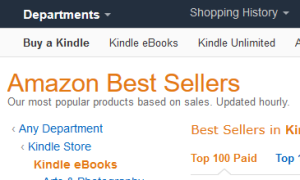
MYTH 1 – Nobody knows how the Amazon Algorithm Works
TRUTH – Yes they do.
The Amazon Algorithm is an A9 algorithm, a pretty run-of-the-mill product search engine with a personalization built in. A9 is a company in Palo Alto that creates product algorithms, code that tells Amazon’s website how to sort and load product lists for each customer’s experience. Anyone who wants to read about how this algorithm works has to do nothing more than search for information online and read the manuals, forums, science articles, and a myriad of other documents that tell you EXACTLY how it works. You can even see samples of the code that makes it work if you look!
This sort of algorithm is an item to item collaborative algorithm. This means it works on a node system. What’s that? It’s like a tree of products, or a catalogue, put in order of hierarchy. That means the information Amazon uses to suggest and deliver products to you when you search for them is based on the finite terms used to describe products entered into its catalogue. The fact it is collaborative means it bases results on factors pertaining to the signed in customer only, factors surrounding that customer’s behavior on Amazon and online, and what is popular that day. It also learns about you, and retains those learnings for search and suggestions.
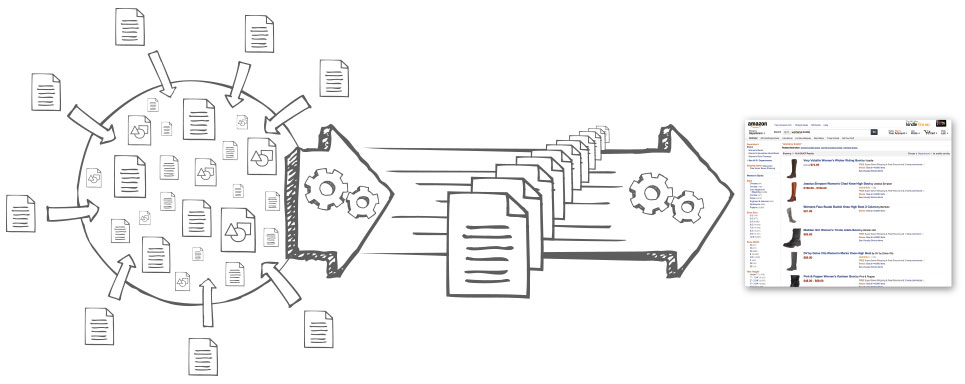
A9 algorithm – pic: A9
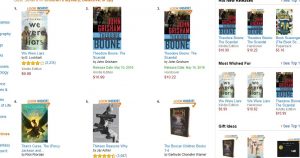 MYTH 2 – Amazon has secret ways of ranking books
MYTH 2 – Amazon has secret ways of ranking books
TRUTH – None of it is secret.
It works according to the algorithm. The factors are already written into the algorithm, which has to be a clear-cut set of commands. There’s no magic here, and it’s simply a case of knowing what factors are used in this sort of algorithm. It’s true that A9 will not be interviewed by the media because of a competitor clause they have with Amazon, but that’s not the same as being magical and clandestine.
Of course, the one part of Amazon’s product promotion that is always going to be confidential is its preferences for pushing certain big-selling products on certain schedules according to publishers and their own agendas. These products, however, still fit into the algorithm and run quite nicely inside its parameters. Products like these are simply put on the site in clear view in ad boxes (such as Easter products over Easter) to push them, which works.
Ranking is influenced by factors that anyone can look up in Amazon documentation (we will discuss in detail):
- A product that is priced well in relation to similar products, but that is priced in a way that will turn the best profit in relation to its competitor
- A product that offers a description that gives bullet points or features that the algorithm will recognize in terms of keyword
- A strong keyword in the title that will help categorize the product (I suggest a subtitle to deal with this)
- Sales in each session period, which is 24 hours, compared to others in your category
- How many times someone clicked on your listing to your product, known as Click Through Rate (CTR)
- Spelling, grammar, editing, and quality of your interior, and also the quality of the cover
- Number of verified reviews, helpful reviews and new reviews –outside of this, unverified reviews do not count towards ranking but do count towards social proof and CTRs (see below)
- Product page is complete in all sections and meets Amazon Guidelines on word count, layout, and image size and quality used.
The MAMM Factor – Amazon’s Objective
Amazon has one objective for its sellers to bear in mind: Make Amazon the Most Money. Amazon expert James Amazio says, “Make Amazon the Most Money in 24 hours by letting them let your product be ranked higher than the other guys. Total Revenue = Number of Products Sold x Sales Price.” That means that each 24 hours counts, so doing a giveaway over three days isn’t going to help Amazon make money, so this doesn’t help ranking or exposure much at all.
Sales and Rank
Sales are not straightforward numbers either. What Amazon looks for is the number of sales for a product with the best profit in its category (Remember MAMM?). So if your book is 99 cents, but another book is selling at $2.99 but not as many as you, it’s likely Amazon will recognize the $2.99 book higher in rank because it makes Amazon more money. This means you need to do some research on what is selling in your potential category before choosing one, and also before choosing your price. 99 cent books may do well in Romance, for example, but maybe in another category you’re pricing too low to show Amazon a good profit margin.
This is also true of certain “publishers” that force authors to price at $16 or more. While this might be their own profit margin covered, it leaves little room for Amazon to make money if the other books are $3.99 in that category, and it’s going to take a lot of sales to convince the algorithm to prioritize your book in ranking if the chances are poor for Amazon sales. It’s not a case of “less sales for more profit.” It’s a case of “what books sell better relative to other books in that category.”
CTR – Click Through Rates – Book Covers DO matter
If you have a high amount of clicks from the Amazon search list generated to your book page, this counts towards ranking. This means your book cover has to be amazing. It has to stand out.
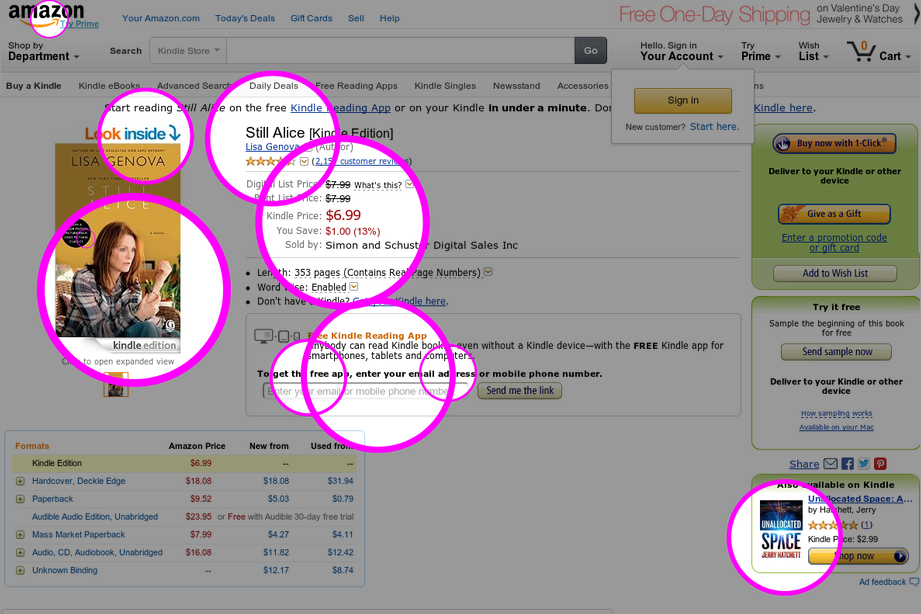 After They Click – Zoning
After They Click – Zoning
Amazon, like most websites, charts where people click on a page. If you hover over buy boxes on pages, this may count towards ranking/inform Amazon about that customer’s preferences for their next search. This means that advice pertaining to what matters on a page really can be burned down to one piece of advice: Make sure every section above the fold on Amazon book pages gets filled out according to Amazon’s guidelines.
If zoning counts, everything you can see without scrolling down, and that includes the number of Customer Reviews shown, matters. We’ve been saying for years that having decent copy and Editorial Reviews matters, and it does. Content of Customer Reviews? Not so much. To see how readers look at reviews on Amazon, check out our eyetracking results report here.
Conversion Rates
What does count is that if someone goes to your page, you need them to buy your book and convert into a sale. By having a properly filled out Book Page you are increasing your chances of that happening. Conversion rate is measured by amount of clicks through against how many sales are made.
MYTH 3 – You can figure out keywords that people will use to find you by typing into the search bar and seeing what is autosuggested.
 TRUTH – The search bar is personalized to YOU and YOU ALONE.
TRUTH – The search bar is personalized to YOU and YOU ALONE.
This is a useless and possibly damaging practice being bandied about by bloggers who think they have uncovered a “secret.” A little knowledge is a dangerous thing. In this case, the lack of knowledge of how an algorithm works is leaving holes in understanding globally on this subject.
Amazon has a department called The Personalization Platform Team. Look ’em up. They spend their time working on coding the search bar to serve absolutely personalized product lists to you. By testing this carefully, it’s easy to see exactly how this works. I spent quite a significant amount of time talking on Moz and other sites to engineers and programmers to understand and clarify this information, some of whom have worked at Amazon.
Testing The Search Box
Lately, my work at SPR has meant I have had to buy a lot of Christian non-fiction to study certain buying behaviors for Christian author clients. As a result, I now have a purchase history that looks like I go to church and read about Christianity on a regular basis even though I don’t. Because of this, I am now served suggestions such as “The Bible Diary 2016” maybe because I bought a diary recently also, and “Hymns for Women.” I guess, because I am a woman.
When I typed “Illustrated…” into my search bar, suggestions are, “Illustrated Bible” and “Illustrated Biblical Stories for Children.” Neither of which are titles of books, but generic product words that maybe more than one product seller has used in their product description.
When my colleague in another location did the same, he got “Illustrated Sex Positions” and “Illustrations.” These suggestions are something of a more secular nature! And maybe because he has lately had to buy a lot of erotica for work clients, and maybe, because he’s a man he got the fiction suggestion, based on books he bought before that were bought by other people at the same time as this one shown. I did not see any of the same results as him, even if I searched for “Illustrated Sex…” It was as if our Amazon catalogues were entirely different.
The factors Amazon uses to autocomplete are as follows:
- What you searched for previously
- What you browsed previously
- What you bought previously
- What other people who are similar in demographic bought before in the same basket
- What categories you search in more often
- Products that Amazon thinks you’d like to know about
- Social media use – Facebook for sure, probably Goodreads, but no others can be confirmed due to trade secrets yada
- IP address history
- GPS data from mobile
- What you’ve clicked on when Amazon recommended a product
There’s also a good amount of Jedi mind trickery going on that you just can’t get into as one lowly author. It seems these myths came about because Amazon wants you to think your autosuggestions are completely based on your own browsing power, and the search bar obsequious. However, one test by the Baymard Institute found, “During testing, autocomplete suggestions were found to directly alter how and what the test subjects searched for. A lot of the test subjects perceived the autocomplete suggestions to be “recommendations” by the site, and therefore showed a bias towards selecting them over using their own query” when in actual fact, these suggestions came from their own preferences and history. You can’t second guess millions of combinations of each reader’s search history to figure out keywords, especially when the only tool you have is your own preferences!
Takehome fact: Do not figure out keywords for your book by seeing what autocompletes in the search box. It’s only based on your own user experience and nobody else’s.
If you want to be a real geek, you can go into personalization in this book by John Berndt.
If you yourself don’t like the idea of being tracked by Amazon outside of Amazon, you can turn off personalization by following these steps. But I wouldn’t recommend it. Your Amazon experience just won’t be the same.
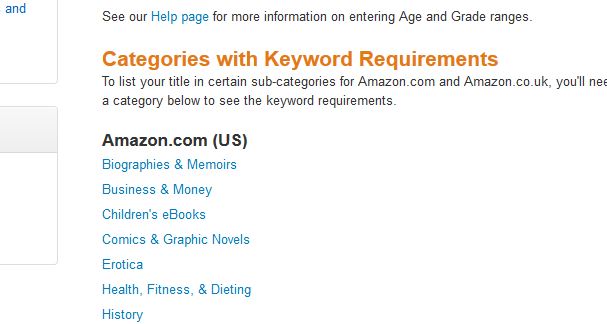 MYTH 4 – It’s a job finding keywords to make your book discoverable and you have to do a bunch of tricks and resort to many author advice blogs to find answers and theories
MYTH 4 – It’s a job finding keywords to make your book discoverable and you have to do a bunch of tricks and resort to many author advice blogs to find answers and theories
TRUTH – Amazon tells you for the most part which ones to use in Amazon Guidelines.
Because Amazon is not Google, that is, it is an item to item algorithm model, you don’t have to struggle to define keywords in the same way. What’s in its catalogue is all it’s going to search for, and it’s going to personalize that so much that the best way to get seen is by keeping your words generic and broad for the most part, combined correctly with categories, and not apart from categories, which is usually bandied about as the effective way of doing this. It is not.
On this list, you will see the search engine will serve up results much more effectively when you use categories that have keyword requirements, and then you stick to those requirements. Here’s the link to the list. No mystery. Just read it off the list. Add it. Get seen. Most author who don’t get seen are not following the rules in other ways, or are using categories that require keywords without using the proper paired words on this list. Here’s another link to a guide offered to authors with fantastic advice.
 MYTH 5 – If you pick a niche category to get to #1 you are just conning everyone that you got to the Bestseller Lists by exploiting the “loophole.”
MYTH 5 – If you pick a niche category to get to #1 you are just conning everyone that you got to the Bestseller Lists by exploiting the “loophole.”
TRUTH – Because this is a node tree system, you are not conning anyone, this is not a “loophole” and you are helping your book.
Here’s a thought. If you ran in a local race, and all but two other contestants dropped out, and you came first, you would still be awarded the gold medal. Then you’d be qualified to run in a regional race. Let’s say in this race, you’ve had a bit more training, and because you won the last race a few more people have turned up to cheer you on. A few have written about you in the paper and online. Because of this, you manage to get the silver this time. And so you move up to a national race. Suddenly, you’re on TV, and getting recognized as a runner.
This is how Amazon works. If you get to number one in a niche category, it shows the algorithm you did OK. This places you (dependent on all the other books on sale that hour and how they perform) in a less niche category automatically, in fact, the one next along the “branch.” If you get a few reviews at this point, and carry on selling, you’ll move up again.
Anyone who says this is a con is obviously not proud of their book. Blogger Brent Underwood, who faked a book to prove Amazon has a “loophole”, should be ashamed. Amazon’s niching wasn’t the con. He was. He stopped two other real books from making the jump, and now some publisher wants to really publish his fake book! He taught us nothing except if you want to tell a lie and get away with it, you can.
That doesn’t mean you should have the takehome that there’s a “loophole” in Amazon. There’s not. It’s not a loophole at all, it’s just a smaller race to win. Ask yourself, would a multi-billion-dollar platform like A9 really have a loophole that some pundit who knows nothing about selling online could “exploit”? If you were to tell someone you won the 100-yard sprint and got a medal at the local apple fair, do you think they would say, “you exploited a loophole! I wouldn’t advertise that medal if I were you!” Of course not! They would congratulate you!
If you are a Best Seller in Non-Fiction-Cooking- International Cooking –Spanish Egg Dishes let people know! Next you’ll be a Best Seller in International Cooking, then Cooking, and then Non-Fiction.
It’s all about consistency and retaining sales. Amazon says, “When we calculate Best Sellers Rank, we consider the entire sales history of a book. Monitoring your book’s Amazon sales rank may be helpful in gaining general insight into the effectiveness of your marketing campaigns and other initiatives to drive book sales, but it is not an accurate way to track your book’s sales or compare your sales in relation to books in other categories.”
 MYTH 6 – You are advised to write to Top Amazon Reviewers and other reviewers to ask for free reviews to boost ranking.
MYTH 6 – You are advised to write to Top Amazon Reviewers and other reviewers to ask for free reviews to boost ranking.
TRUTH – This can result in some terrible, horrific scenarios for the career of your book and should be avoided.
Amazon’s algorithm can sense if you have been in touch with the reviewer, number one. This can result in the review being removed by Amazon or worse, your book taken out of the ranking system altogether.
One guy on Reddit recently wrote to say he had followed advice given on a certain author group recently, only to be reviewed with one-star reviews from Top 1000 reviewers accusing him of spamming them. His book was completely ruined. These methods may have worked some time ago, but now reviewers (me included) are pretty tired of unsolicited emails and many of us have removed our email address from our Amazon profiles.
The best way to get reviews on Amazon is to advertise your book using tried and tested methods that will not have you connected or communicating with the reviewer in any way. These methods include advertising on Amazon, Goodreads, and more notably for results, Facebook.
Number of Customer Reviews vs. Content of Reviews vs. Gifting and Swaps i.e. Free Reviews
First, only Verified reviews technically count towards ranking. Gifted books have to be picked up fast: “A gift sale counts towards a sales rank only if it’s redeemed within 24 hours by the recipient” so any review you get from gifting or sending your book out for free to reviewers? Doesn’t directly count towards ranking if they don’t redeem it quick enough. This means what you need are Verified Reviews, i.e. reviews as a result of a sale. Amazon looks at the number of verified reviews, new reviews (less than a month old) and reviews that have been upvoted as factors towards ranking.
Since June 2015, the algorithm has given “more weight to newer reviews, reviews from verified Amazon purchasers and those that more customers vote up as being helpful. A product’s 5-star rating, which previously was a pure average of all reviews, will also become weighted using those same criteria, and so may change more often,” reports CNET.
At SPR we offer a mailing promotion service to readers who buy and review books with a guaranteed number of sales, within Amazon Guidelines. Look for services that offer both guaranteed sales and reviews if you are looking for Verified Customer Reviews.
![]() Social Proof and CTR
Social Proof and CTR
Getting your free reviews may help with social proof. If customers look at the number of reviews only, and you have 200 4 star average reviews, they may click your listing over someone else’s. This in turn helps your CTR for ranking. During research it seems between 40 and 60 reviews is the consensus between experts on hitting minimum social proof your product is good.
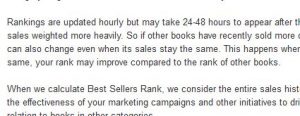 MYTH 7 – Nobody knows when the algorithm updates
MYTH 7 – Nobody knows when the algorithm updates
TRUTH – We do. It’s in Amazon KDP’s Manual
Sometimes people talk about the Amazon Algorithm and when it’s going to “update.” By this, two different things are meant. First, we can talk about when ranking will update. Amazon KDP says, “Rankings are updated hourly but may take 24-48 hours to appear after the first completed sale.” Some people talk about when the algorithm will update when they want to know when Amazon will change the parameters, or how the algorithm functions and lists products. However, these changes are imperceptible to sellers including authors, and generally are weighted towards helping you sell.
 How Can I Use This Information? Best Practices For The Amazon Algorithm
How Can I Use This Information? Best Practices For The Amazon Algorithm
You have a good opportunity to fill out your Book Details correctly using Amazon Guidelines. Here are the main points to help your rank:
- Get an amazing book cover to increase click through rates – plus, any other photos you add should be at least 1000px
- Synopsis should not be more than 4000 characters.
- Use 7 generic keywords that describe sub-genre, mood, and location, not words that relate only to your book.
- Do NOT use keywords more than once in keyphrases because this can look like “keyword stuffing,” a spammy practice that can get you dropped in ranks.
- Never use brand names or company names as it’s against Amazon Policy
- Make sure if your category has keyword requirements, you use those keywords
- Add Editorial Reviews because these go above the fold and will be seen a great deal more than Customer Reviews and give you a one-shot chance to sell your book to new readers – these are also essential if you put your book on Pre-Order, because you can’ t get Customer Reviews at this point
- Use your Author Central page to link all your books. Selection is a ranking factor, so make sure customers can find your selection of books if you have more than one. Amazon is committed to showing series books on the same page, but you must tell them your books are linked by using the series details in your admin, such as numbering your books.
- Merge print and ebooks, and different editions by writing to Amazon Support. This will merge all reviews for all versions of your book too, giving you a higher amount of reviews for your product under one listing with more selection.
- Verified Reviews are a ranking factor, so the more reviews the better. Aim to reach 40-60 reviews overall minimum to hit social proof that your book is worth buying, and aim for new ones every month.
Get an Editorial Review | Get Amazon Sales & Reviews | Get Edited | Get Beta Readers | Enter the SPR Book Awards | Other Marketing Services


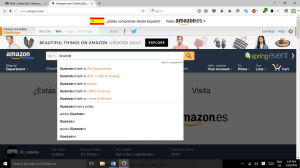 TRUTH – The search bar is personalized to YOU and YOU ALONE.
TRUTH – The search bar is personalized to YOU and YOU ALONE.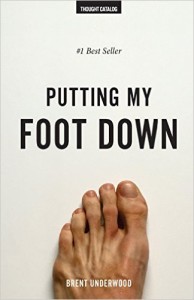 MYTH 5 – If you pick a niche category to get to #1 you are just conning everyone that you got to the Bestseller Lists by exploiting the “loophole.”
MYTH 5 – If you pick a niche category to get to #1 you are just conning everyone that you got to the Bestseller Lists by exploiting the “loophole.”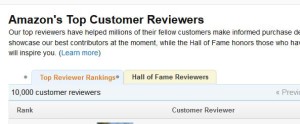 MYTH 6 – You are advised to write to Top Amazon Reviewers and other reviewers to ask for free reviews to boost ranking.
MYTH 6 – You are advised to write to Top Amazon Reviewers and other reviewers to ask for free reviews to boost ranking.



















Cate, this is GOLD. Very well done.
Thanks!
Firstly, of course there’s a bias here since SPR sells review packages. There’s a lot of solid work that’s been documented around the various algorithms affecting different behaviors on the Amazon site in the book space that this article fails to take into account.
There are multiple algorithms at play, just as there are multiple rankings authors routinely discuss. That’s demonstrable. A recommendation/personalization algo, a bestseller algo, a poplist algo, a search algo, etc. As well, some lists and behaviors are derived directly from other lists. For example, the Kindle Unlimited and Kindle Countdown rankings are derived from the poplists.
Reviews likely figure somewhat into the personalized recommendations Amazon displays and possibly the search results (although review ratings are a FILTERABLE search result field, so best guess is that they do not play a large role in the relevancy, or default, basic search), but for bestseller ranking? Nah. For poplist ranking? Probably not.
It’s concerning that a “search expert” would maintain that “A product that offers a description that gives bullet points or features that the algorithm will recognize in terms of keyword” influences rank in some way. Descriptions are not indexed metadata fields. At least search results are not predicated in any way on description copy.
To base much authoritatively on Amazon documentation is also a slippery slope as the help documentation is quite often lacking. Depending on what help pages you look at, for instance, borrows from Kindle Unlimited may be neither discussed nor acknowledged as playing into the rankings during normal sales and during Select Free days. Weightings for free books, borrows, and exclusions of sales from certain ad sites are not discussed anywhere in Amazon’s help documentation that I’ve found.
Price is a factor in the algorithms that populate the poplists. Price is not a factor in determining bestseller ranks. Different algos produce different results.
Rank in the bestseller list is influenced by sales and velocity. Since sales history is weighted in, it takes fewer sales the longer a book is at a given rank to maintain that rank. THAT’s what’s meant by Amazon’s assertion that watching the bestseller ranks isn’t an accurate way to track and compare your book in relation to other books.
An *algo* can “sense” if you’ve been in touch with a reviewer? And a review from a gift that doesn’t count toward rank also doesn’t count in the algo? What do these statements even mean in this context?
Finally, has anyone documented any review averages changing according to the newish machine learned model Amazon instituted last summer? I would think there would be some indication, at the very least between incremental scores such as 4.2 and 4.3, budging them one way or the other based on recency, most helpful, etc, but while the reviews may change displayed position a bit, I haven’t seen any indication of weighting taking place in the overall average.
Yes, there are plenty of myths out there. But some of those authors you neglected to talk to have been discussing this stuff for years, not just a few months.
Hi Phoenix
I think it’s a shame every book professional is weighted with such
suspicion. This article came from a good, generous, and honestly
interested place (and yes, posted on our website, where we market books). A career must be about passion for your subject as
well as making a buck, I am sure you agree. This is mine.
I see you’ve been on other forums about me and about the delay in response instead of giving me more than a few hours to respond. My mum died a few days back and it’s been very tough for me – we’re still not over the funeral. I have not been at work so much. I did manage to publish this to schedule. I felt it would be helpful to authors that I had been talking with, and that warmed me.
Then, I saw your tour online.
As this is such a long comment, I am going to reply at length, but the crux of the matter is this: I did not do my research in a few days. I did not speak with authors during my research because I work with authors 14 hours a day every day for the past 5 years. In that time, we have helped something like 200 authors or more reach the bestseller ranks with legitimate and simple techniques listed at the end of this article. I spend most of my time talking with authors and book marketing experts. I did NOT “neglect” to talk with authors! The whole reason I did this was because I listened to so many authors getting this wrong over and over again. SPR has been around for nearly 9 years now, and we have a lot of intel.
The very reason I wrote this piece is that there is much disinformation
passing into “fact” on places like the K Boards, of which I see you are
an active member.
I interviewed algorithm programmers as well as many experts in this field. I am not talking about K Boards people, I am talking about the people who code and work on these issues every day.
Lately, I have come across so many comments that make no sense to me about A9 and how it works. So I went into the coding side of things.
My findings are not educated guesses. They are facts with citation. I have been very careful about this. You say “solid work” and yet you don’t cite anything at all, because actually there is a lot of solid work out there with the wrong premise – take the myth of the search box autocomplete for example. You cannot work on conclusions from an incorrect premise. I could list hundreds of so-called articles on author sites, even renowned ones, that are just wrong, and nearly all are from authors taking results they think they have as proof, instead of asking for information on how the algorithm is actually put together.
Why do you say “multiple algorithms?” It’s one algorithm, I name it and cite it. A9. I can see you are listing factors that add to that one algorithm. An algorithm is a set of step-by-step instructions to a result. It’s a collective noun for a set of processes, such as search and rank. From thereon in, you are not using technical terms, or understanding basic concepts, but you think you do. That’s what is happening everywhere online with authors on forums, which why books are not selling.
You also scoff at well-documented and cited facts in the piece, and say that factors that Amazon have even announced as factors are not. You ask many questions here I have actually answered in the article. For example, “Finally, has anyone documented any review averages changing according to
the newish machine learned model Amazon instituted last summer?” I cite this in my article with comments from Amazon, and say changes are imperceptible to the user, as Amazon told us in statements and my links.
You also deny straight up and down facts. “Price is not a factor in determining bestseller ranks.” I have cited two links at least straight from the horse’s mouth that it is a factor, and I explain why in detail.
I am not just a “search expert” as you so kindly “”. I am a book expert that ranks books highly every day as well as a specialist in my field. I have a degree in digital design and IT and worked at a Google company on international brands, and then as a much-in-demand consultant at top agencies in three countries. I have nearly 20 years experience with marketing and publishing.
I thought you must be very successful as an author as you speak with such authority. I was therefore surprised to see, despite how prolific you are, you have 2 customer reviews on one listing, 1 review on another, and considering your rankings, out there in the #thousands, wrong categories, wrong keywords, wrong pricing, not following basic advice given on basic KDP guidelines, you are in the sticks. Which is a shame, because I could do wonders with your books. They are well-written.
I suggest, given your own position on Amazon, you give my advice a go. Many authors have, with great results.
As Popper once said, “True ignorance is not the absence of knowledge, but the refusal to acquire it.” Unfortunately I see an awful lot of posturing from authors on forums and not a lot of book selling.
Hence the article.
I don’t think it’s possible to have a conversation with you Phoenix, you are so angry that I wrote this for some reason! I know you and many other authors want to blame their tools (or me), want to be right, and anything I say you will reply that the moon is purple.
But honestly, I do hope you can think about trying out some of the advice here to salvage your books. Maybe then you can come back with your results and we can have a dance.
Email any time for more tips on how we can get your books selling: editor@selfpublishingreview.com.
I’m very sorry about your mum, Cate.
As for your reply, I believe you’re still missing the target on some of your points. I’m not sure you’re going to be receptive to any of the research that I and my colleagues have conducted on this topic. It’s out there. Reams of it. And yes, it’s solid.
As for my credentials, I see you must have missed my medical thriller with 325 reviews, which has earned over $30,000 and which has been as high as #4 overall paid on B&N, in the Top 100 paid on Amazon several times, and #1 overall free on Amazon. If you use a rank tracker program, you’ll see its history.
Over the past 4 years I have also managed 150 titles for various clients, one of which made the New York Times list for 2 weeks and the USA Today list for 6 weeks, and another which hit the USAT list. I work mainly with backlist and in my capacity as director of Steel Magnolia Press, I’ve shepherded the sales of just over 1.5 million books and have given away another 1.8 million. Together with the 6 individual authors under the Steel Magnolia umbrella, we’ve seen probably 60 titles in Amazon’s Top 100 paid, 40 titles in the Top 100 paid at BN, and 50 books in Amazon’s Top 100 free. As I head toward retirement, we’ve reverted rights to all our titles except for 75 under a small handful of pen names between two authors.
On Saturday, one of the books under my management hit #1 overall Free and 2 other freebies hit in the #30s. Currently, we have 3 titles (one is mine under a pen name) in the Top 16 Romance titles on the Countdown list. During our weekend campaign for 3 of the pen names I manage, we gave away 55,423 books, sold another 1177 over average, and racked up over 366,000 page reads on the targeted books.
One of my newer releases that you noted above is in a box set managed by another author right now, and I’m not heavily marketing that series until the box has finished its run on July 1. By then, Book 3 will be out and I’ll concentrate on selling the series.
I appreciate your offer of help, but I believe I can manage my titles — under all my pen names — as well as my clients’ titles quite well on my own.
Am I angry about your post? When I see folk confuse authors more than most already are with disinformation, yeah, I get a little miffed. You may not agree with my and my colleagues’ findings any more than I agree with all of yours. All I can do is look at my “facts” and see they don’t all jive with yours.
But I do thank you for responding.
So the book that did the best is also the book with the most reviews – that potentially proves the point that reviews are a factor. Obviously a book that sells more will have more reviews, and there’s a chicken and the egg issue, but it makes sense for Amazon to weigh reviews as a ranking factor if they want to push books that people like.
Getting loads of downloads for romance titles is a different game entirely because of romance’s intrinsic popularity – sometimes regardless of quality. What works in romance proves little about how the system works for other genres.
Most of the criticism of the post suggest that there are different algorithms – specifically one for search and one for ranking. What is your proof of that? As mentioned in this piece, you can’t test search b/c each person’s experience on Amazon is unique. But doesn’t it also make sense that Amazon would weight search results based on book popularity? This is the same way Google works – popular posts rank high in results. Putting them in totally separate camps makes very little sense.
It seems so obvious that I can’t imagine why people are arguing the point. Why would Amazon separate search and bestseller rank? They inform each other. If you rank high in search for some term, and no one buys the book after clicking it, this will affect your bestseller rank. Conversely, it makes little sense for Amazon to show a book in search results with 100 1-star reviews and no rank. So they’re part of the same algorithm, as the results of one affect the results of the other.
Amazon itself says: “If other books have recently sold more often than your book, your book’s
Best Sellers Rank may stay the same or even drop. Your sales rank can
also change even when its sales stay the same. This happens when other
books experience a decrease in average sales.”
So sales rank is determined by more than sales. The algorithm has to look at conversion rate for other books to determine rank – a process that happens within search. And if reviews help with search placement, they’ll help with sales ranking, which will improve search placement, and so on. That’s what makes it an ecosystem. Again, I’m not sure why this is being argued against, as it makes so little sense for sales and search to not be in communication with each other.
“So the book that did the best is also the book with the most reviews – that potentially proves the point that reviews are a factor.”
Well, no. It potentially proves that a book that’s been on sale for 4+ years and has been promoted 20 or so times might have made more money so far overall than a book out for 4 weeks with no promo push whatsoever. To even indicate the possibility without taking sales longevity into account is…confusing.
An assumption you’re making is that my research and analysis was conducted in a vacuum, when in reality much of it was done in conjunction with another group of interested colleagues (who I mentioned several times in my previous posts) with different browse histories and different devices.
What you seem to be conflating throughout are the different types of “rank” in the Amazon ecosystem. There’s the bestseller rank, which, I think you HAVE to agree is not a personalized list. It has its own set of calculations (an algorithm, if you will) that includes current sales with a weighted history of past sales over time. Additionally, borrows — at time of borrow — count as a sale in the algo. Nothing else influences it. Not price, not reviews, not conversion rate.
Proof? Thousands of documented results across devices, world regions (all accessing the .com site), customers, browsers, etc. that can be charted, replicated and predicted across time.
Then there is the poplist rank, which Amazon never actually refers to in its documentation … go have a look, I’ll wait … but which is what is served to the reader who’s there to browse. It’s the order of books that are served when the customer clicks on the left-hand nav bar on the website or when a customer selects “browse” on a device. It’s what Amazon would prefer customers browse by because they like to influence those rank displays.
Rank order here is what Amazon wants it to be, so they weight accordingly. Do reviews play a part? Perhaps. Does conversion play a part? Perhaps. Interestingly, rank on the poplist (the defaulted filter used to be called “popular”, hence the name; now it’s termed “featured”) can be closely predicted based on a 30-day rolling cycle of sales. Devices might display the lists a little differently — it’s clear that the list on the website riffs off of the “Books” catalogue search, while the Kindles and Fires riff off of the “Ebooks” catalogue search. But results can be closely predetermined without any of that information, so whatever part they play in the algo, if any, is negligible. Not denying their social value, but for ranking purposes in the poplist, negligible.
What does weight highly?
– Sales*
– Free downloads (0.1 of a sale’s weight)
– Price
What doesn’t weight at all?
– Borrows or page reads
– *Sales or downloads that come from BookBub’s email or website
Note these are observations from the .com site. The UK site was running an older version of the algo the last time any of my group tested it. I don’t know what the weightings are for freebies or by price bias or whether BookBub transactions get excluded on sites other than .com.
Then there’s the search ranking. This is where the A9 engine comes into play. This is where the results or products of the ranking algorithms are fed into the engine to create a 3rd list of results that’s personalized to a user’s experience.
“Best Sellers Rank may stay the same or even drop…So sales rank is determined by more than sales. The algorithm has to look at conversion rate for other books to determine rank”
How do you make this logic leap? That isn’t what the Amazon quote says at all. For instance, sales volume over the entire store fluctuates and influences how many sales it takes on any given day to hit or maintain a rank. Your assumption above is that sales across the store are static each day. They, of course, are not. If you sell 5000 books today and hit a rank of #5 and tomorrow Amazon and BookBub run a huge deal across 10 highly popular books that each sell 10,000 copies, then if you sell 5000 books again tomorrow, your rank will fall to at least #11 despite selling the same number of copies. It’s a simple comparative calculation.
“It makes so little sense for sales and search to not be in communication with each other.”
I’ve never said sales and search were not communicating. I AM saying sales algos across the bestseller and pop lists are run separately and displayed in their separate lists independent of the search algo. The search algo (A9) includes the results of, likely, the poplist algo in its calculations. But the results and the lists are independent of one another.
What doesn’t weight at all?
– Borrows or page reads
– *Sales or downloads that come from BookBub’s email or website
Where is your evidence for this? We run a newsletter list service and it has a demonstrable effect on rank. Why would Amazon block Bookbub paying customers? And you’re saying that it’s impossible for authors in KDP Select to rank? You’ve lost me.
Anyway, nobody’s saying that search and bestseller use exactly the same criteria. Obviously, they’re different functions. You don’t believe that they share factors in determining rank. Cate has laid out how they do. Agree to disagree at this point.
I would be receptive if you were using the correct terminology and had read my article properly, or my comment. I can’t argue with a wall. We’ll leave it there.
Correct terminology? Educate me on what the official name is for the browse list which Amazon pushes customers to that is NOT the bestseller list? (I believe I might have coined the term “poplist”, which is shorthand for “the browse list you access from the nav bar on the left side of the webpage”). If there’s a correct and official term, I’m happy to use it here instead of the colloquial one many indies now use to describe this list.
You do realize the bestseller list and the poplist are two different and distinct lists offering different visibility?
Why is the poplist important to visibility? Because:
– It is the list Amazon points customers to in its emails and other online advertising. Amazon does very little with the bestseller list, opting to favor poplist rank over bestseller rank when determining visibility.
– The poplist provides a 30-day rolling period of visibility.
– It is responsible for the 30-day cliffs seen after a promo because of the strict 30-day period.
– It is the list that determines rank of books in the Kindle Unlimited lists.
– It is the list that determines rank in the Countdown lists.
It is different from the search list. It is different from the bestseller list. It is at least as important — if not more so — than both.
Sales and downloads from the BookBub mails and website absolutely do affect the *bestseller* lists. They are not weighted into the *poplist*. What this does is mitigate the sales tail after a BookBub run and not allow BookBub to have an undue influence on its lists, while not strangling its effect on the bestseller list.
Evidence… Observed. If we take 100 books and 99 of them don’t have a BookBub promo during our target time, we can fairly accurately predict the poplist ranks of those 99 books based on sales. If we include sales or free downloads that originate from BookBub for the 100th book, the rank falls far, far short of prediction. If we exclude those sales, the predicted rank matches the actual rank. Over and over. Replicable and predictive results.
Your original point was that BookBub wasn’t weighted “at all.” Again, point still stands – there’s criteria governing search, poplist, and bestseller – weighted differently, but feeds from the same place: the algorithm. The main point of argument is you’re saying there are several algorithms at play on Amazon. Cate has shown there is 1 algorithm that feeds to results in different lists, places etc. It’s basically saying the same thing – with minor differences about what’s factored into each list, and how they’re connected.
The response to these criticisms is here: https://www.selfpublishingreview.com/2016/05/mythbusting-the-amazon-algorithm-part-ii-amazon-lists-products-and-sales/
Definitely not correct terminology…
Cate, A9 is the product search algo. The bestseller rank is different.
Yes, this is the point I tried to explain in the replies to your comment on my ALLi article, Cate. You’re confusing sales rank (in which pricing is not considered) with search results (where pricing is a definite factor).
I strongly recommend you read Phoenix’s research and the subsequent work by Data Guy over at Author Earnings. In addition to being authors and bloggers, they are also the leading researchers in this area with formidable technical backgrounds.
Beyond that, there is some excellent mythbusting here, particularly about autocomplete being customer-specific.
Condolences on your loss, I’m very sorry to hear about it.
I am not confusing anything. Read what I wrote and you can see it’s clearly cited with factual evidence, not amateur testing. Nobody needs to be testing it out or researching something so well documented. Hence this article, I say again. A closed circle of misinformation is going on in the indie author realm, because the people you are heralding as experts are simply not. Neither am I to the extent an algorithm engineer is, so I went to find out. I wonder why people refuse to learn, especially when it’s in their best interest. It’s bizarre. We will leave it there, this is exhausting.
Read it. Nope. All incorrect.
No it isn’t.See part II. I address this very widespread misunderstanding.
This Sullivan woman, (a retired veterinarian and clearly not a tech native) is touting herself as an “expert” on Amazon on K Boards when she has covers like this: https://www.amazon.com/Vet-Tech-Tales-Confessions-Animal-ebook/dp/B006LFQA52 – Literally a kitten cover with an 80s font. If you poke about her reviews, clearly around 95% have been bought on either Fiverr or she’s got friends to write for her. All have totally awful covers, and several have editorial issues and formatting issues. Her synopses run off the page. She has no author photo. There’s a paid service of some kind outside of Amazon T and Cs to have got such blindingly fantastic reviews because she’s embarrassed she cannot get real reviews and has built herself up so highly. Complete amateur – and a liar trying to save face. Cate, carry on and ignore the hobbyists. Amazon search is going to become a hugely professional concern in the search market in the next two years and people like this won’t be able to keep up with the professionals and their books will drown – quite rightly. I’m a search director (went to Ivy League to study this) and we are using info like this to start building resources for serious Amazon sellers. Thanks and keep it up. We know you are part of the industry. It’s clear from what you write here. Too many blind leading the blind when so many professionals do this every day and have been to college for just that. When I need something for hairballs, I’ll contact Sullivan.
Thanks for the support, glad you enjoyed the article.
EXCELLENT! Thank you for posting this. You’ve done a great service to the community. I’ve always known the “keywords from the search bar” issue (obvious because they come up so quickly, they have to be cached). But I’ve given up trying to argue the point. All the others are excellent and well researched. You’re the BEST!
Thanks!
Your writings definitely bear out what my own experience has been over the past 26 months. This is just terrific stuff and thank you so much for doing it!
Thanks so much for the information!
Very informative article. I’m definitely curious about a few aspects:
1.) Myth 7. What you stated about keywords being more keyed to an Amazon customer’s past searches and purchases makes sense. But is that still the case when a customer is no longer signed into Amazon? Wouldn’t a clean search (browser history, cache and cookies cleared) represent a more pure search of what results certain keywords would bring up?
Also, the reason why many of us authors try different variations of keywords is because the generic keywords stated in the Kindle FAQ bring up hundreds of thousands of results. No indie author in their right mind will have a snowball’s chance of being seen using those types of keywords.
2.) Myth 6. The info on Verified Reviews verses non-Verified was extremely helpful. I’d heard about how the verified ones help ranking and this pretty much confirms. Many of us authors are simply trying to make our books more attractive to potential readers, as we all know that a book with no reviews usually gets avoid.
Also, about the author you mentioned who got a string of 1 star reviews for contacting Amazon’s Top 1000 Reviewers. My question to that is, did he contact them all in a mass email or individually? If it was the former, then that was dumb on his part. If he simply contacted them separately and received such a negative response, then what is the best way to request a review from the Amazon Top 1000 crowd?
Again, thank you for posting this article.
Hi, to answer your point about “clean” browsing: no. Because you cannot second guess all the other users and how their searches collaboratively affect what you are seeing. However clean you search, their results will impact the listings anyway.
As for keywords, I do understand that has been a widespread piece of advice. However, as Amazon is a finite catalogue, it is about hitting a combination of keywords and categories rather than niching yourself into oblivion. Your best bet is looking at what your competitors are using and going with those generic words at the time you want to promote – see part II of this series for more.
I wrote a piece about approaching Top 1000 reviewers (of which I am one) here:https://www.selfpublishingreview.com/2016/01/how-not-to-ask-for-a-free-review-from-a-top-1000-amazon-reviewer/.
Best information I’ve seen yet, and I published my first Kindle Book circa 2008. Keep up the good work!
Thanks! Hope part II gives you more info.
Great article, thank you. My own question relates to categories and keywords. I have found exceptionally conflicting advise on this one, and to be frank found the guidelines on Amazon unhelpful. So my categories are ‘Action and Adventure’ and ‘Historical Fiction’. My books are about African and English family sagas set in South Africa, England and Rhodesia (now Zimbabwe). Can anybody give me any guidance as to the types of keywords I could use? Much appreciated.
Hi Peter, your best bet is to consider more niche categories first off. Your categories are too broad. You should look at books you like on Amazon that are similar to yours and see what categories they use. For instance, “historical- Africa” might be better for you. Then you can build time and place keywords such as “20th century” and “apartheid” (I am guessing what your books are about but you get the idea). Good luck!
Thanks Cate for your reply. Appreciated. The books already sit under African Historical Fiction, and the keywords you have indicated have given me the right response I needed. I think some I’ve used are in the wrong direction. So thanks very much.
No problem, Peter. Good luck with your books.
Wow! What a great article – super informative and relevant to me as an author. I will consider your service in the future.
Thanks for your support!
Wow! That keyword stuffing statement made me go yikes. It might be why my ranking continues to plummet. Need to go and assess those.
With regard to keywords. Do add-ons such as Kindle Spy really help in determining strong keywords to include when doing keywords for your book. They do seem to provide words I’ve not considered, because they’re not words I’ve used in my selection of keywords.
Do you have any correlation data toward giving away free books and their leading to follow up buys?
Finally you state, “personalization in this book by John Berndt.” I might have missed the title, could you point it out, please. Thank you for a thought provoking review.
Yes, Kindle Spy is a good one. But you must use it just as you want to change your keywords to go against competitors.
Although I don’t have data, I have experience with trying out Free. Free books and paid books are two separate entities on Amazon – one rank doesn’t help the other. I don’t think free books lead to sales except if you have a series, and you stagger prices, i.e. free, 99 cents, 2.99 etc. Plus free on Amazon means you will have to price match and have your book somewhere else, unless you are doing a promotion. In which case this could build reviews, and will get you into lists in Free categories for more exposure.
The book is :
https://www.amazon.com/Personalization-Mechanics-Targeted-Content-Teams-ebook/dp/B00UKS4PYE/.
John also has many videos on
YouTube:https://www.youtube.com/watch?v=ryIL8fZg8xk.
Thanks so much!!
Hear, hear! Lots of priceless info. I completely agree on the so-called “niche keywords”. They just don’t work, period. In my experience, the broader and more generic the keyword the better it works.
Thank you very much!
What a fascinating post!
Myth #3 was especially intriguing. Between what you said here and what others have said — especially what others have said regarding accessing Amazon via an incognito window — I decided to try a test. My point here is this: Some say that to keep your own search history from influencing what Amazon serves up via those autosuggestions, you should log out of Amazon and then access it via an incognito window. The first time I went to try this — months ago — and I saw what Google itself said on the splash page that came up, I immediately did not believe what I was being told. Google is indicating that my browsing info will not be saved in Chrome(!), not that Amazon won’t have access to it. After all, Google also says on that incognito splash page that “[my] activity might still be visible to: websites [I] visit, [my] employer or school, [my] internet service provider.” There is no setting in my browser that can stop Amazon’s servers from saving info about what I do/look at/buy on their website.
I still decided to do a test, anyway. For the first part of the test, I was logged into my Amazon account. I chose to search using the category “Kindle Store,” and typed in “action” (something I don’t believe I’ve ever searched on before). Amazon gave me the following autosuggestions:
• action adventure
• action comics 1006
• western action adventure free ebooks
• action bible
• action romance
• action
• actionable gamification
• action books
• free action books
Some of those make good sense given what your article says, others not so much (to me, anyway). Anyway, while still logged into Amazon, I opened an incognito and did the same search … and got the same results.
Then to test the idea promoted by others about the incognito window, I logged out of Amazon, and I also deleted Chrome’s cache back to the beginning of time, quit out of Chrome, then relaunched it, and did the same search, but only in an incognito window … and got the exact same results … again!
Methinks the nonsense promulgated about the incognito window is just that, nonsense. The point of the incognito window is obvious: to not save your browsing history, to not save/store any cookies the site you’ve visited wants to foist upon you, and to not save any info you type into forms, which is probably a good idea in certain circumstances, but in other circumstances (as noted by Google) that incognito window won’t do you an ounce of good.
Hi there
I am published, not self published , but I hope you can help. My publishers, unfortunately, have posted my book for publication on Amazon and then posted it again, so there are two listings for the same book. I am nearing 50 reviews in total for both listings but half that for each individual listing, of course. Will Amazon look at each listing separately when counting reviews or add them together?
It depends. If when you search for your book there are all editions showing on one page, it’s okay. But by the sounds of it you need to merge your editions. You can find help here: https://kdp.amazon.com/en_US/help/topic/G200652220